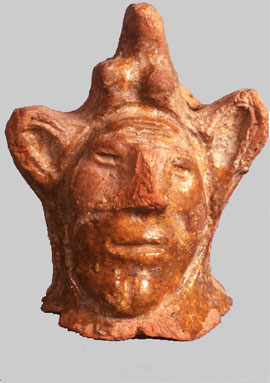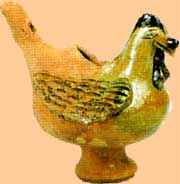 |
: hullabaloos |
||||||||
The exorcist virtue of the sound is universal. The man always sensed the need for making noise to ward off his anguishes vis-a-vis imbalances which he perceives around him. It is the source of the many hullabaloos when the community feels in danger. Vis-a-vis the imbalance of the seasons (winter solstices) or vis-a-vis events calling into question the stability of the village community (marriage of the widowers or widows with young people...), the man drives out the danger with these unorganized noises. The whistle, possibly made with clay according to the areas, finds an obvious place in these demonstrations. If the flute is often associated with the drum to make music, whistles and rattles are the 'disorganized' reflection of these instruments often used in the hullabaloos. |
|||||||||
 Whistle in the shape of head of jester. Found in Tattershall City and County Museum of Lincoln (the U.K.) |
The carnival: the whistle is often associated with the carnival during the Middle Age. The carnival was born from the fusion of the old Celtic festivals of the gathering of the mistletoe and the Roman saturnales. The major part of Saturnales (from the 17 to December 23) moved on the festivals of end of the year at the 4th century. This period of carnival originally covered the period of December 25 to the Epiphany and the Christian church had to accept these overflows before channeling them little by little. The primitive period of the carnival is full of meanings because it also corresponds to the twelve days cycle ratified to the synod of Tours in 567 which connects the old date of the celebration of the birth of Christ (06/01) to the new date of December 25. It is also the time which makes it possible to balance the 354 days of the lunar year to the 365 days of the solar year. It is probably within the course of these festivities that the children of Rome passed from house to house with whistles in the shape of masks during the festivities of New Year's day in 1143. In the former Low Countries, the clay whistles used for the carnival were probably the many whistles in the shape of a head of jester produced in the area. One knows the importance at the time of the celebrations of the Shrove Tuesday of the jester brotherhoods capped with a bonnet named "coqueluchon". Such whistles in the shape of a head of jester were also found in France or England |
||||||||
| The oldest form reproduced of a "coqueluchon" is a headgear in form of a cuculle finished by a head of rooster. Metal whistles in alloy of lead and tin found in Paris but also in Orleans or in England reproduce heads of capped men with a bonnet decorated with a rooster. There too, this rooster returns us to the cockfights organized to Thursday-Jeudiot of the carnival inside the universities and which saw being held true sacrifices of cock locked up in baskets. The goal was to decapitate the rooster with eyes bandaged using a stick or a sabre. The winner decorated his headge with the head of the sacrificed animal. Can we also imagine in the clay whistles in the shape of rooster the evidence of this same type of use? |
 Water whistle in the shape of a rooster. 16th century Whistle found in Fosses. Valley of the Oise (near Paris) preserved in the MNATP |
||||||||
| Another imbalanced time of the Christian calendar is the Maundy Thursday. In this 10 days cycle, it is at the time of the office "of darkness" that the whistle intervenes. Prohibition to sound the bells between the Maundy Thursday and holy saturdays intervenes circa the 8th century. It is as from this time that appeared the intervention of faithful in the ritual with noise and din (Van Gennep). These dins are found before 1900 in many areas of France.
Thus in Guyenne, in Lignan, young people used clay horns, snails of sea and "nightingales" small water whistles in the shape of a jug. In Languedoc, these water whistles were named "nightingales of the Maundy Thursday". This use is not specific to the clay whistle because, depending of the areas and villages, the metal or willow whistles had the same use. Another but less pleasant hullabaloo for those which were the object of it was that which accompanied the marriages between a widower and a young girl or a widow and a young man. These hullabaloos were also carried out around the offences of adultery. This use is widespread as Mr. Gouellain wrote in 1879 to describe the clay whistles: "This small instrument of musical ceramic is not only used to boo with its strident notes the virtuosos of third order caught in rupture of ranges; (...) it is used as a toy for the children." (Notes about musical ceramic)In all these cases, the village community thus expresses its reprobation vis-a-vis an event which puts in danger the harmony of its operation.
|
|||||||||